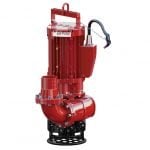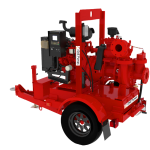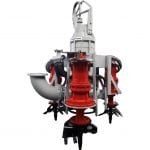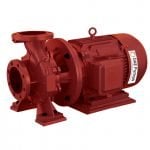Top 8 Considerations for Selecting a Slurry Pump

This Article Includes
- What Makes a Slurry Pump Different from a Traditional Industrial Pump?
- Top 8 Slurry Pump Considerations
- Submersible Slurry Pumps by DAE Pumps
- DAE Pumps – Going Above and Beyond
Need Help?
Our team of engineers is standing by to help you with your next project. Call us at (760) 821-8112 or submit a request.
What Makes a Slurry Pump Different from a Traditional Industrial Pump?
A slurry pump is different from many other types of pumps due to its ability to pump very thick, viscous, abrasive, and heavy fluids that are either particle and/or solid laden. To pump this type of fluid is very demanding and most traditional types of pumps just cannot get the job done. A slurry pump is designed with extra-large flow paths through the wetted portion of the pump, and has the ability to maintain fluid velocity so that the fluid does not settle inside the volute and clog the pump. As a rule of thumb, traditional pumps are more suited for thin fluids because they do not include the design features of a slurry pump; they usually have tight internal tolerances between the impeller and the inside of the volute of the pump, which impedes the flow of thick, viscous, particle and solid laden fluids associated with slurry applications.
Slurry pumps are also made of materials that withstand a great deal of abrasion from the abrasive slurries that these specialized pumps are suited to. These types of pumps must also be durable enough to withstand rocks going through the pump, which have a tendency to bounce around inside of the pump as they pass through the wetted housing, which can cause cracking, ruptures, and catastrophic pump failure. Slurry pumps can endure the greater punishment that is inherent in slurry applications. Slurry pumps are subjected to the most extreme circumstances and perform well in many industries, including pumping sand, dredging, mining, oil and gas, fracturing, and many other application types that pump thicker fluids.

Top 8 Slurry Pump Considerations
The following is a list of 8 considerations for choosing a slurry pump best suited for a slurry application. Selecting a pump for a slurry application is more difficult than for an application involving thinner fluids. If a mistake is made in the pump selection process, the pump chosen will most likely not work well, or will not pump the higher viscosity, abrasive, heavy, solid laden fluid at all, which renders the new pump useless!
- Know the Material or Fluid Being Pumped
The fluid or material type and its characteristics are among the most important considerations. Is it a slurry, mud, sand, etc.
- Fluid viscosity of the material, usually measured in centipoise (CPS).
- Density of fluid, usually measured as specific gravity (Sg)
- The pH level, which is the measure of hydrogen-ion concentration.
- Static and operating temperature of the fluid.
- Pump Flow Rate
- Flow rate is another important factor for selecting the best-suited pump for a slurry application. The pump must be capable of exceeding the required flow rate to ensure desired flow rates are achievable (example of flow rate: 350 GPM or 200 cu. yards per hour {cu-yd/h}).
- The flow rate of the pump must not only achieve the required flow rate of the application, but it must also be more than something called the critical flow rate. The critical flow rate is the constant flow rate required to maintain the suspended particles and solids in the slurry. Maintaining suspension of particles and solids helps to avoid the heavy portion of the fluid from settling at the bottom of the wetted path, as well as from settling at the bottom of the discharge piping.
- Flow velocity is a critical consideration; the material must move at a consistent velocity through the piping to keep the slurry, particles, and solid-laden material suspended so it does not settle and cause clogging.
- Materials of Construction
The materials that the pump is made of are necessary because the pump must be chemically compatible with the fluid being pumped. If the pump’s materials of construction and the liquid are not consistent, it can cause the pump to either melt down or crack, resulting in catastrophic failure of the pump, and can also cause damage to the immediate area surrounding the application and cause injury to workers.
The pump must also handle the abrasive characteristics of the fluid being pumped. If not, abrasive fluids can scour through the pump casing and cause premature wear of the internal pump components such as the rotor or impeller.
- Inlet & Discharge Pipe Considerations
Pipe length, diameter, and the type of material of the piping are essential factors that are often not strongly considered when constructing a pumping system.
- Pipe length is essential because the more significant the size of the pipe, the more fluid or material build-up will occur, requiring a more substantial amount of motor power to enable the pump to continue pushing the fluid or material to its final destination.
- Pipe diameter should be sized considering two factors, reducing discharge head pressure and maintaining sufficient fluid or material velocity to avoid clogging of the discharge pipe. Regarding both reducing discharge head and maintaining adequate fluid velocity, the rule of thumb is to go more extensive on the pipe diameter, which will help to alleviate the adverse effects of both factors.
- Pipe material should not only be chemically compatible with the fluid or material being pumped, but when selecting piping that has a reduced surface finish at the inside of the piping, it can also minimize pipe friction loss which can result in less energy required to pump the fluid or material to its final destination. The surface finish measure is denoted as Ra, which stands for Roughness Average.
- Motor Power
Motor power, usually indicated by horsepower (HP), is important on any pump but wildly when pumping slurries and fluids with high specific gravity and viscosity because thicker, heavier fluids require a more significant amount of power and force to move the fluid or material to the desired final location.
The motor power must also be sufficient enough to overcome any forces within the discharge piping downstream of the pump. These forces within the discharge piping could be a result of pipe components such as tees, bends, and upward grades that create something that is referred to as discharge head pressure which is measured in PSIG.
- Pump Operating Cost
Another important consideration that most pump user does not think about is the cost and economic impact of the pump. Having the best-suited pump for an application also includes how much money it requires to keep that pump running for whatever duration it is in service. It not only has the energy the motor uses but also involves selecting a pump that can move viscous material with low amounts of water or accompanying fluids.
Water and accompanying fluids used to make pumping viscous solid laden material possible can cost a lot of money. If these fluids can be reduced, it can save thousands of dollars on operating expenses.
- Pump Elevation
The pump must be located in a manner that does not hinder its operation of the pump. In applications where the pump is positioned above the fluid to be pumped, the pump cannot be located higher than the pump’s ability to draw the liquid into the pump intake. If the pump is positioned at an elevation that is greater than the pump’s ability to remove the fluid into the pump, the result will be that the pump will not achieve prime, and the desired flow rate will not be reached, or even worse, the pump will not pump the fluid at all.
- Pump Orientation
One last point to mention is pumped orientation. Pumps can be purchased with several different orientation options. The most common are vertical and horizontal, which refers to pump shaft orientation. Depending on the specific application, vertical and horizontal pump orientations can be the better choice. Horizontal orientation is the most purchased orientation, but vertical orientation can be better suited when a pump is used in a smaller space.
Check Out Other DAE Pumps Products
Submersible Slurry Pumps by DAE Pumps
DAE Pumps manufactures heavy-duty premium Submersible Slurry Pumps designed for a wide range of slurry applications, including pumping slurry, sand, and other heavy viscous solid laden materials. These pumps can flow at rates more than 2,000 GPM with fluids containing particulates and large solids. Submersible Slurry Pumps by DAE Pumps can also move fluids with a water density up to 14.18 lb/gal., pH values from 2 to 10, and can handle solids up to 2.5 inches in size.
Considered one of the most challenging and most durable submersible slurry pumps in the industry, these pumps are made of high-quality lightweight materials that are corrosion and abrasion-resistant. They are manufactured with heavy-duty bearings to withstand shock, high chrome impellers for extra wear resistance, and are offered with a broad pump base for added footing stability. These pumps are available in 3-in. to 8-in. and enclosed motors with power options up to 102 HP.
For more information on DAE, Pumps Submersible Slurry Pumps, go to:https://www.daepumps.com/products/submersible-slurry-pumps/
DAE Pumps – Going Above and Beyond!
DAE Pumps is a premium industrial slurry pumps and dredge equipment manufacturer. Offering unparalleled performance for many different industries, DAE Pumps are ideally suited for Oil & Gas, Mining, Construction, Marine, Municipal, Water & Wastewater, and many other industries. Along with the high-quality pumps DAE Pumps offers, we also provide world-class service to assist you no matter what the pumping challenge.
DAE Pumps Product Categories
All pumps by DAE Pumps are made of the highest quality materials; they are durable, long-lasting, and provide value beyond your expectations. No matter your industry, DAE Pumps has a pump specifically suited for your needs.
Need Help?
Our team of engineers is standing by to help you with your next project. Call us at (760) 821-8112 or submit a request.








